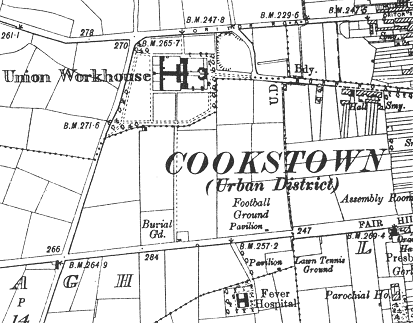Cookstown, Co. Tyrone
Cookstown Poor Law Union was formally declared on the 22nd 1839 and covered an area of 151 square miles. Its operation was overseen by an elected Board of Guardians, 21 in number, representing its 16 electoral divisions as listed below (figures in brackets indicate numbers of Guardians if more than one):
Co. Tyrone: Ballyclog, Ballynasallus, Beaghmore, Coagh, Cookstown (2), Killeenan, Killycolpy (2), Lower Lissan, Munterevlin (2), Oaklands, Orritor, Pomeroy, The Rock, Sandholes, Stewartstown (2), Tullyhog (2).
The Board also included 7 ex-officio Guardians, making a total of 28.
The population falling within the Union at the 1831 census had been 44,624 with divisions ranging in size from Beaghmore (population 895) to Munterevlin (4,396).
The Guardians had their first meeting on 25th October 1839. The Board appointed William Ballantine as clerk to the Union at a salary of £30 per annum. The Guardians later held their meetings each week on Saturday.
The new Cookstown Union workhouse was erected on a 6.5-acre site on the road to Orritor at the west of Cookstown. Designed by the Poor Law Commissioners' architect George Wilkinson, the building was based on one of his standard plans to accommodate 600 inmates. Its construction cost £5,250 plus £1,050 for fittings etc. Construction work began in May, 1840, and was originally scheduled to be completed within twelve months. However, due to bad weather, and problems accessing a particular quarry, delays ensued. The workhouse was eventually declared fit for the reception of paupers on 31st May 1842 and admitted its first inmates the same day.
The workhouse location and layout are shown on the 1909 OS map below.

Cookstown workhouse site, 1909.
The buildings followed Wilkinson's typical layout. An entrance and administrative block at the east contained a porter's room and waiting room at the centre with the Guardians' board room on the first floor above.
The main accommodation block had the Master's quarters at the centre, with male and female wings to each side. At the rear, a range of single-storey utility rooms such as bakehouse and washhouse connected through to the infirmary and idiots' wards via a central spine containing the chapel and dining-hall.
The Guardians' minutes (Johnston, 1996) record the bedding and clothing to be supplied to the new workhouse:
- 220 blankets and the same number of bed covers
- 280 sheets, 240 bed ticks, 200 bolster ticks
- 96 suits to be made of 'barragan', 72 for boys
- 120 wrappers of blue twilled chambray for women
- 120 flannel petticoats, 84 frocks for girls, and the same number of flannel petticoats
- 324 shirts
- 408 shifts in addition to 49 for little children
- 156 men's caps and 240 women's caps.
The supply of provisions to the workhouse caused some difficulty due the reluctance of local dealers to commit themselves to a fixed price contract and a guarantee of continuous supply.
During the famine in 1847-8, a 75-bed fever hospital ('The Fevery') was erected at a site about half a mile south of the workhouse. A paupers' graveyard lay between the two sites.
In December 1841, the Guardians appointed the first master and matron of the workhouse — Robert Campbell and his wife at salaries of £35 and £25 per annum respectively. John Mason was appointed schoolmaster at £15 a year, and Miss Mary Millar at £12 a year "indoor" — with board and lodging included. John Morris was engaged as the first porter at £10 a year with a suit of clothes and top hat also provided. However, the delays in completing the workhouse meant that none of these received any payment for another six months. Two weeks before the opening of the workhouse, Mr and Mrs Campbell went to Londonderry for training in workhouse management and discipline. They received a subsistence allowance of two shillings a day while away.
The Campbells did not stay long in their posts. Robert Campbell received warnings about misconduct and in April 1843 serious charges (whose nature is unrecorded) were laid against him by the Guardians, with evidence being given by the schoolmaster and schoolmistress, the medical officer Dr Hamilton, and inmates Eliza Marshall (laundress) and Ann Yarrow (infirmary nurse). As a result, the Campbells were found unfit to continue in their posts but were allowed to stay until successors were appointed.
At the 1901 census, the population of the Union was 23,615.
The Cookstown Board of Guardians stayed in existence until 1948. In its later years, the workhouse buildings were increasingly used for administrative purposes, including the distribution of outdoor relief, and as a Food Office from where local rationing was organised during the Second World War. The buildings are have been demolished with the exception of a small part of the dining hall which contains a date plaque — probably from the workhouse entrance block. The fever hospital was demolished in about 1970 after half a century of lying derelict.

Cookstown dining hall block from the north-east, 2003.
© Peter Higginbotham.
Records
Note: many repositories impose a closure period of up to 100 years for records identifying individuals. Before travelling a long distance, always check that the records you want to consult will be available.
- Public Record Office of Northern Ireland, 2 Titanic Boulevard, Titanic Quarter, Belfast BT3 9HQ. Holdings include Board of Guardians' minutes (1839-1948); Miscellaneous committees minute books (1879-1918); Workhouse registers (1899-1948); etc.
Bibliography
- The Workhouses of Ulster by Michael H Gould (1983, Ulster Architectural Heritage Society).
- Workhouses of the North West Edited by Jack Johnston (1996, WEA)
- The Workhouses of Ireland by John O'Connor (Anvil Books, 1995)
Links
- None.
Unless otherwise indicated, this page () is copyright Peter Higginbotham. Contents may not be reproduced without permission.


